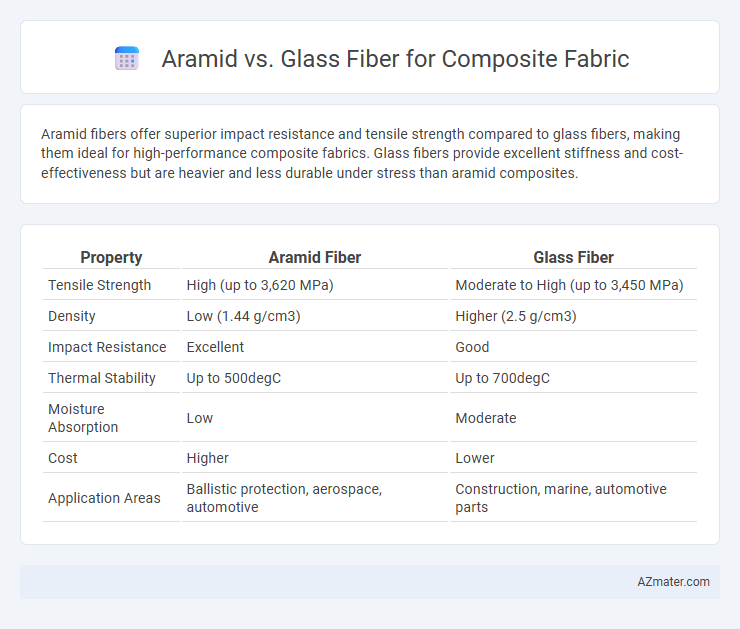Aramid fibers offer superior impact resistance and tensile strength compared to glass fibers, making them ideal for high-performance composite fabrics. Glass fibers provide excellent stiffness and cost-effectiveness but are heavier and less durable under stress than aramid composites.
Table of Comparison
| Property | Aramid Fiber | Glass Fiber |
|---|---|---|
| Tensile Strength | High (up to 3,620 MPa) | Moderate to High (up to 3,450 MPa) |
| Density | Low (1.44 g/cm3) | Higher (2.5 g/cm3) |
| Impact Resistance | Excellent | Good |
| Thermal Stability | Up to 500degC | Up to 700degC |
| Moisture Absorption | Low | Moderate |
| Cost | Higher | Lower |
| Application Areas | Ballistic protection, aerospace, automotive | Construction, marine, automotive parts |
Introduction to Composite Fabrics
Composite fabrics combine fibers with resin matrices to produce materials exhibiting enhanced mechanical properties such as strength, durability, and lightweight characteristics. Aramid fibers, known for their high tensile strength, impact resistance, and thermal stability, are preferred in applications requiring exceptional toughness and ballistic protection. Glass fibers offer excellent stiffness, cost-effectiveness, and corrosion resistance, making them suitable for structural components where rigidity and affordability are critical factors.
Overview of Aramid Fiber
Aramid fiber, known for its exceptional strength-to-weight ratio and high tensile strength, is a synthetic fiber widely used in composite fabrics for aerospace, automotive, and protective gear applications. Its outstanding impact resistance, thermal stability up to 500degC, and excellent fatigue resistance make it a preferred choice over glass fiber in environments where durability and safety are critical. Aramid's low density and superior energy absorption properties contribute to lightweight, high-performance composites that outperform glass fiber in ballistic and structural reinforcement uses.
Overview of Glass Fiber
Glass fiber, composed mainly of silica, is widely used in composite fabrics due to its high tensile strength, excellent thermal stability, and cost-effectiveness. It offers superior resistance to moisture and chemical corrosion, making it suitable for a variety of industrial applications including automotive, aerospace, and construction. Compared to aramid, glass fiber provides a higher modulus of elasticity, ensuring enhanced rigidity and dimensional stability in composite materials.
Mechanical Strength Comparison
Aramid fibers, such as Kevlar, exhibit superior tensile strength and impact resistance compared to glass fibers, making them ideal for applications requiring high mechanical durability. Glass fiber offers high compressive strength and stiffness but typically demonstrates lower elongation at break and impact resistance than aramid composites. The mechanical strength comparison highlights aramid composites as better suited for dynamic load-bearing environments, whereas glass fibers excel in rigidity and cost-effectiveness.
Weight and Density Differences
Aramid fibers exhibit a lower density of approximately 1.44 g/cm3 compared to glass fibers, which typically have a density around 2.5 g/cm3, making aramid composites significantly lighter. The reduced weight of aramid fiber composites offers superior strength-to-weight ratios beneficial for aerospace and automotive applications requiring high performance with minimal mass. Glass fiber composites, despite being heavier, provide higher stiffness and cost advantages but are less optimal where low density is critical.
Thermal and Chemical Resistance
Aramid fibers exhibit superior thermal resistance with a decomposition temperature around 500degC, maintaining mechanical integrity under high heat, while glass fibers typically withstand temperatures up to 480degC but become brittle over time. Chemically, aramid resists organic solvents, fuels, and acids better than glass fiber, which may degrade or weaken in corrosive environments. These properties make aramid composites ideal for aerospace and automotive applications requiring enhanced durability against heat and aggressive chemicals.
Cost Effectiveness
Aramid fibers generally offer higher strength-to-weight ratios and superior impact resistance compared to glass fibers, but their production costs are significantly higher. Glass fiber composites provide a more cost-effective solution for applications requiring moderate strength and durability, making them popular in industries with tight budget constraints. For projects prioritizing budget over peak performance, glass fiber delivers better cost efficiency while retaining acceptable mechanical properties.
Applications in Industry
Aramid fibers, known for their exceptional strength-to-weight ratio and high impact resistance, are extensively utilized in aerospace, military, and automotive industries where durability and safety are critical. Glass fibers offer cost-effective reinforcement with excellent tensile strength and electrical insulation properties, making them ideal for construction, marine, and wind energy applications. Both fibers enhance composite fabric performance but are selected based on specific industry requirements such as weight sensitivity, mechanical properties, and environmental conditions.
Durability and Longevity
Aramid fibers, such as Kevlar, offer exceptional durability with high tensile strength and excellent resistance to impact and abrasion, making them ideal for long-lasting composite fabrics. Glass fibers provide good durability with high stiffness and resistance to moisture, but they are generally more brittle and prone to fatigue over time compared to aramid. The superior toughness and fatigue resistance of aramid composites typically result in greater longevity in demanding structural and protective applications.
Choosing the Right Fiber for Your Needs
Aramid fibers, known for their exceptional strength-to-weight ratio and impact resistance, are ideal for applications requiring high durability and lightweight performance, such as ballistic protection and aerospace composites. Glass fibers offer excellent tensile strength, corrosion resistance, and cost-effectiveness, making them suitable for automotive parts, construction materials, and general-purpose composites. When choosing the right fiber, consider factors like mechanical performance, environmental exposure, weight constraints, and budget to optimize your composite fabric for specific industry demands.

Infographic: Aramid vs Glass Fiber for Composite Fabric
 azmater.com
azmater.com